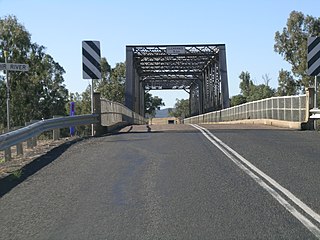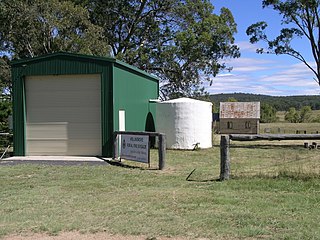
Grafton is a city in the Northern Rivers region of the Australian state of New South Wales. It is located on the Clarence River, approximately 608 kilometres (378 mi) by road north-northeast of the state capital Sydney. The closest major cities, Brisbane and the Gold Coast, are located across the border in South-East Queensland. At the 2021 census, Grafton had a population of 19,255. The city is the largest settlement and, with Maclean, the shared administrative centre of the Clarence Valley Council local government area, which is home to over 50,000 people in all.

Gwydir Highway is a 568-kilometre (353 mi) state highway in northern New South Wales, Australia. The highway was named after the Gwydir River, which in turn was named after a locale in Wales.

Glen Innes is a parish and town on the Northern Tablelands, in the New England region of New South Wales, Australia. It is the centre of the Glen Innes Severn Shire Council. The town is located at the intersection of the New England Highway and the Gwydir Highway. At the 2016 census, Glen Innes had a population of 6,155.

Clarence Valley Council is a local government area in the Northern Rivers region of New South Wales, Australia.

Summerland Way is a 199–kilometre state route, designated B91, in New South Wales. It runs generally north from Grafton to the state border with Queensland just west of Mount Lindesay, and continues from there into Queensland as Mount Lindesay Highway. It was named as the region in runs through is a popular tourist area for people during summer.

Capertee pronounced is a village 46 km north of Lithgow, New South Wales, Australia. It is on an elevated site above the Capertee Valley. In 2016, the township had a population of 145 people. The Castlereagh Highway links Capertee with Lithgow to the south and Mudgee to the north. The township is surrounded by National Parks and grazing land. Principal employment is in coal mining, farming and tourism-related services. The Capertee Valley forms a part of the catchment area of the Hawkesbury River, but the village lies very close to the Great Divide watershed, with the Turon River catchment nearby to its west.

Conargo is a town in the Riverina region of New South Wales, Australia. The town is in the Edward River Council local government area. It is on Billabong Creek, a tributary of the Edward River. The nearest towns are Jerilderie and Deniliquin. At the 2006 census, Conargo had a population of 188 people.

The Clarence River is a river situated in the Northern Rivers district of New South Wales, Australia.

Seaham is a suburb of the Port Stephens local government area in the Hunter Region of New South Wales, Australia. It is located on the Williams River which flows into the Hunter River 14.6 km (9.1 mi) downstream from Seaham village at Raymond Terrace.

Moulamein is a small town in New South Wales, Australia, in the Murray River Council local government area. At the 2016 census, Moulamein had a population of 484. Moulamein is the oldest town in the Riverina.

Nambucca Heads is a town on the Mid North Coast of New South Wales, Australia in the Nambucca Valley. It is located on a ridge, north of the estuary of the Nambucca River near the Pacific Highway. Its 2021 population was 6,675, including 5,226 (78.3%) Australian-born persons and 672 indigenous persons.

Wee Jasper is a hamlet in the Goodradigbee valley at the western foot of the Brindabella Ranges, near Burrinjuck Dam in New South Wales, Australia in Yass Valley Shire. It is located about 90 km north-west of Canberra and 60 km south-west of Yass. At the 2021 census, Wee Jasper and the surrounding area had a population of 127.

Bourke was an electoral district of the Legislative Assembly in the Australian state of New South Wales from 1880 to 1904, including the towns of Bourke and Cobar. It elected two members simultaneously between 1882 and 1889 increasing to three members until 1894, with each elector being able to vote for as many candidates as there were vacancies.

Harrow is a town in the Wimmera region of western Victoria, Australia. The town is located in the Shire of West Wimmera local government area, 391 kilometres north west of the state capital Melbourne, overlooking the Glenelg River valley. At the 2016 census, Harrow and the surrounding area had a population of 200.

Wellingrove is a village located on the Wellingrove Road about 20 kilometres (12 mi) north west of Glen Innes, New South Wales on the Northern Tablelands, New South Wales, Australia. At the 2006 census, Wellingrove had a population of 113.
The Gibraltar Range is a mountain range in the Northern Tablelands region of New South Wales, Australia. The range extends off the Great Dividing Range at Bald Nob about 25 kilometres (16 mi) east northeast of Glen Innes and trends generally east northeast and north northeast for about 100 kilometres (62 mi) to the junction of Timbarra and Clarence rivers. It forms the watershed between these two rivers.

The Glen Innes Examiner, previously published as the Glen Innes Examiner and General Advertiser, is an English language newspaper published bi-weekly in Glen Innes, New South Wales, Australia.
Augustus Ryan Fraser was a politician and pastoralist in New South Wales, Australia.
George James MacDonald was a Commissioner of Crown Lands in the British colony of New South Wales where he founded both the city of Armidale and the town of Balranald. He is mostly remembered for his role in leading a contingent of Border Police troopers in a large massacre of Indigenous Australians in the Clarence River region. MacDonald was also considered a talented linguist and writer, producing several published works of poetry and prose reflecting on his experiences in Australia.
Dalmorton is a locality in the Northern Rivers region of New South Wales, Australia. There once was a village of the same name, which was associated with gold mining. Much of the area of the locality is now reserved as National Parks or State Forests. At the 2016 census, the population of Dalmorton was four.
















